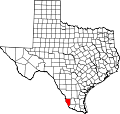2020 census
San Ygnacio CDP, Texas – Racial and ethnic composition
Note: the US Census treats Hispanic/Latino as an ethnic category. This table excludes Latinos from the racial categories and assigns them to a separate category. Hispanics/Latinos may be of any race.| Race / Ethnicity (NH = Non-Hispanic) | Pop 2000 [20] | Pop 2010 [21] | Pop 2020 [19] | % 2000 | % 2010 | % 2020 |
|---|
| White alone (NH) | 47 | 18 | 39 | 5.51% | 2.70% | 7.74% |
| Black or African American alone (NH) | 10 | 0 | 0 | 1.17% | 0.00% | 0.00% |
| Native American or Alaska Native alone (NH) | 1 | 2 | 0 | 0.12% | 0.30% | 0.00% |
| Asian alone (NH) | 0 | 0 | 0 | 0.00% | 0.00% | 0.00% |
| Pacific Islander alone (NH) | 0 | 0 | 0 | 0.00% | 0.00% | 0.00% |
| Other Race alone (NH) | 0 | 1 | 0 | 0.00% | 0.15% | 0.00% |
| Mixed race or Multiracial (NH) | 2 | 0 | 0 | 0.23% | 0.00% | 0.00% |
| Hispanic or Latino (any race) | 793 | 646 | 465 | 92.97% | 96.85% | 92.26% |
| Total | 853 | 667 | 504 | 100.00% | 100.00% | 100.00% |
As of the census [22] of 2000, there were 853 people, 253 households, and 198 families residing in the CDP. The population density was 556.7 inhabitants per square mile (214.9/km2). There were 355 housing units at an average density of 231.7 per square mile (89.5/km2). The racial makeup of the CDP was 79.13% White, 1.17% African American, 0.35% Native American, 17.35% from other races, and 1.99% from two or more races. Hispanic or Latino of any race were 92.97% of the population.
There were 253 households, out of which 44.7% had children under the age of 18 living with them, 58.9% were married couples living together, 15.8% had a female householder with no husband present, and 21.7% were non-families. 20.6% of all households were made up of individuals, and 11.9% had someone living alone who was 65 years of age or older. The average household size was 3.37 and the average family size was 3.97.
In the CDP, the population was spread out, with 33.6% under the age of 18, 11.4% from 18 to 24, 23.9% from 25 to 44, 19.7% from 45 to 64, and 11.4% who were 65 years of age or older. The median age was 30 years. For every 100 females, there were 107.5 males. For every 100 females age 18 and over, there were 101.4 males.
The median income for a household in the CDP was $16,563, and the median income for a family was $19,375. Males had a median income of $17,344 versus $12,188 for females. The per capita income for the CDP was $6,968. About 48.2% of families and 54.5% of the population were below the poverty line, including 61.1% of those under age 18 and 25.4% of those age 65 or over.











